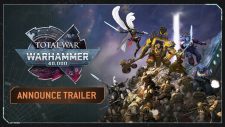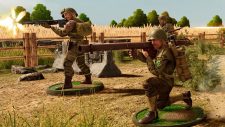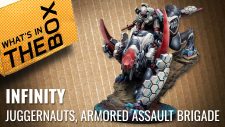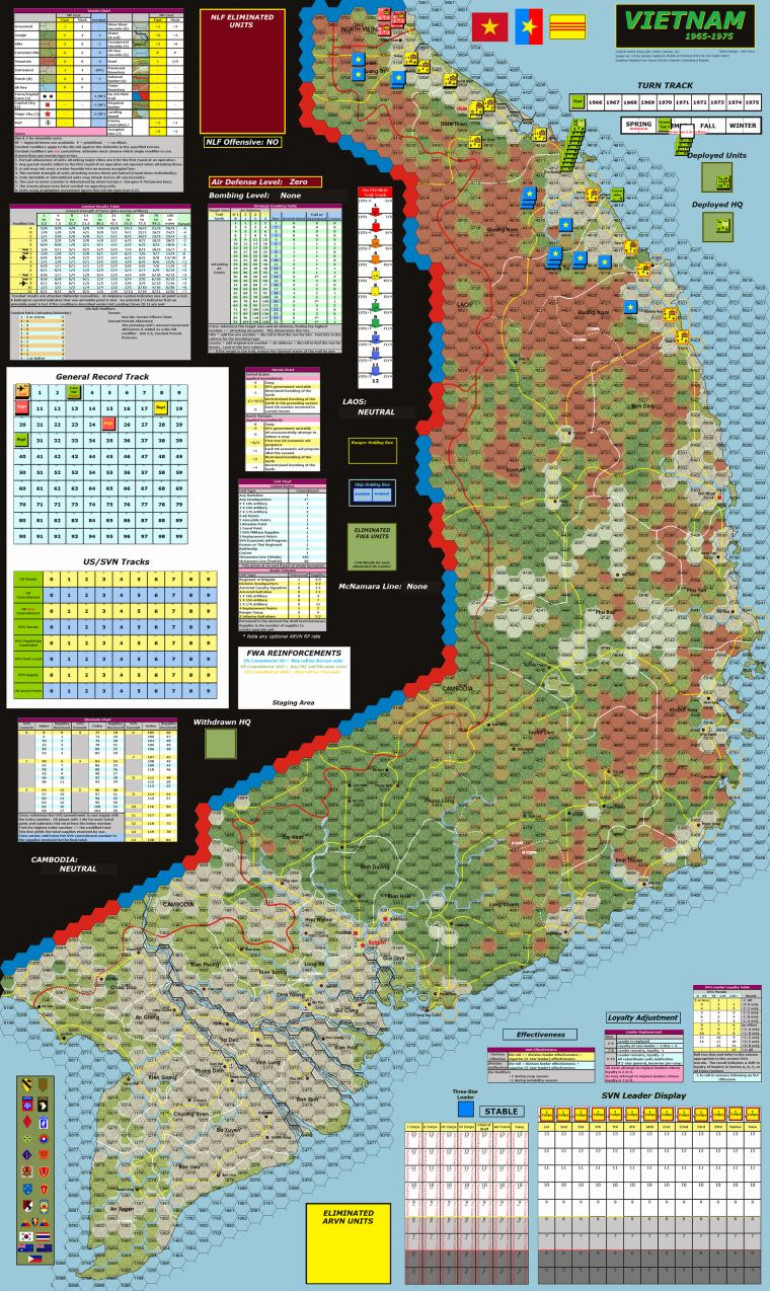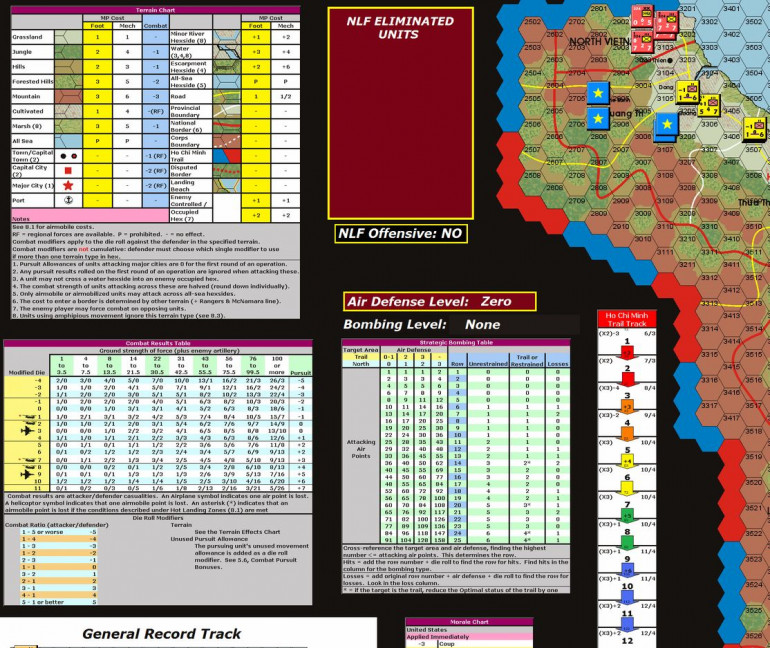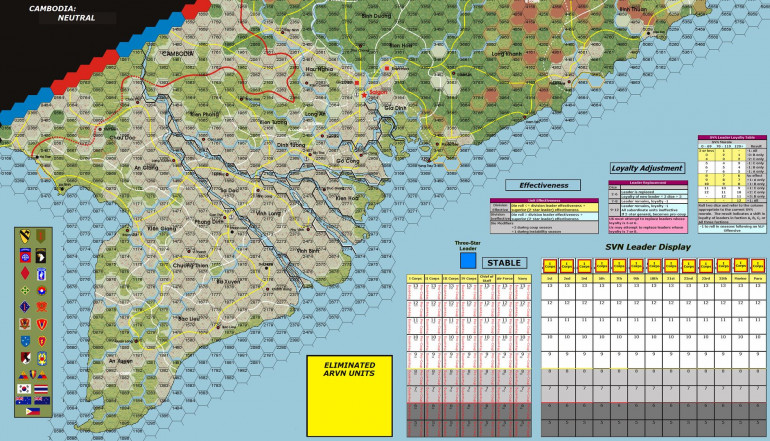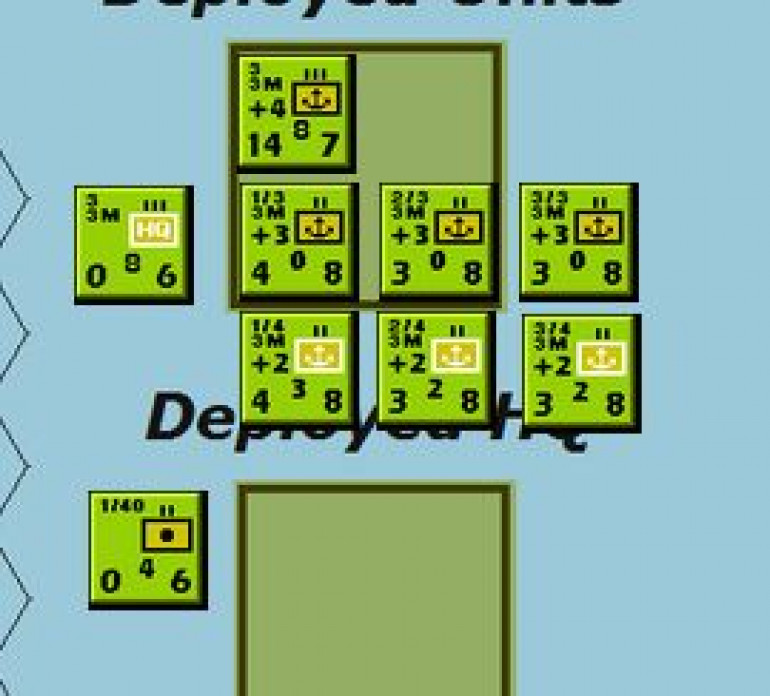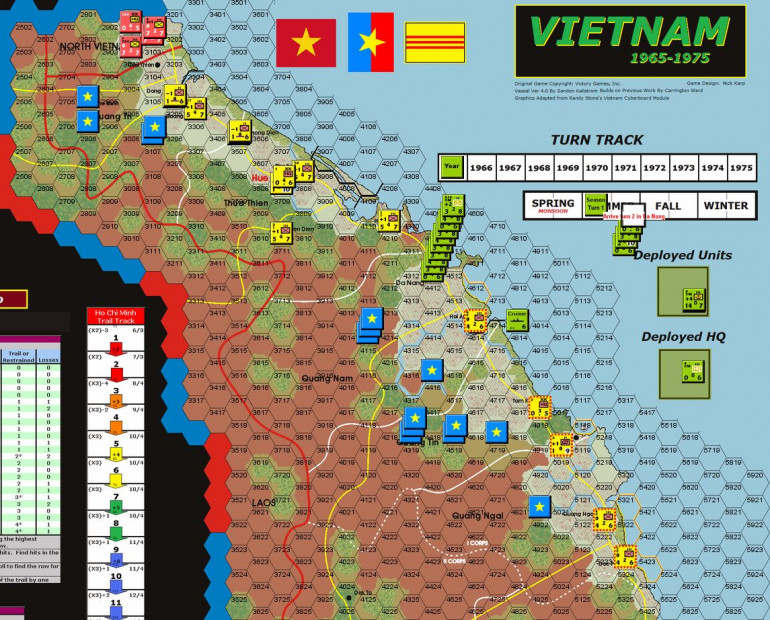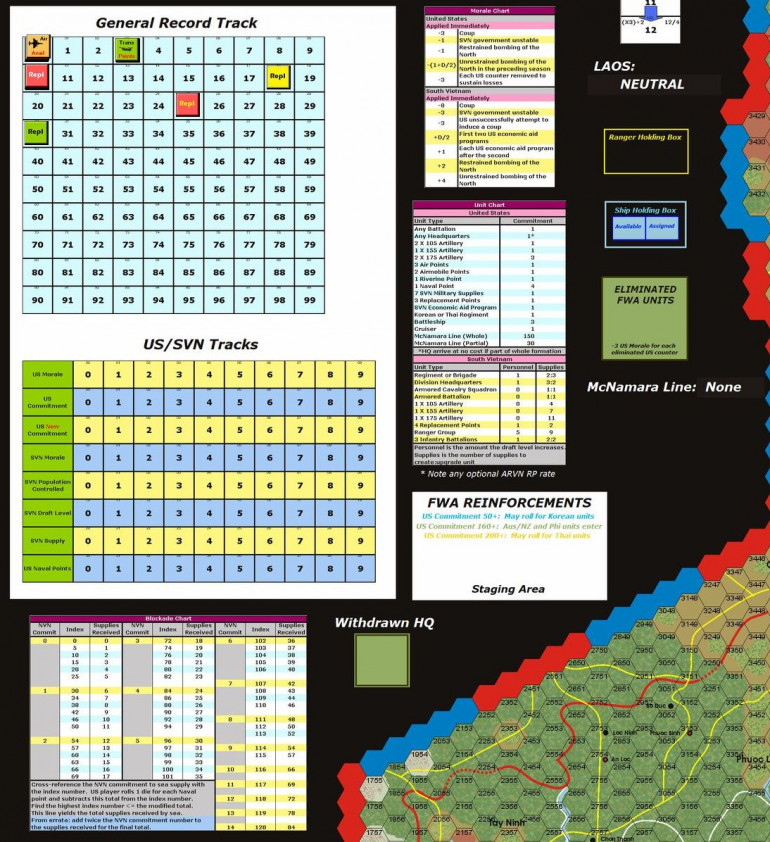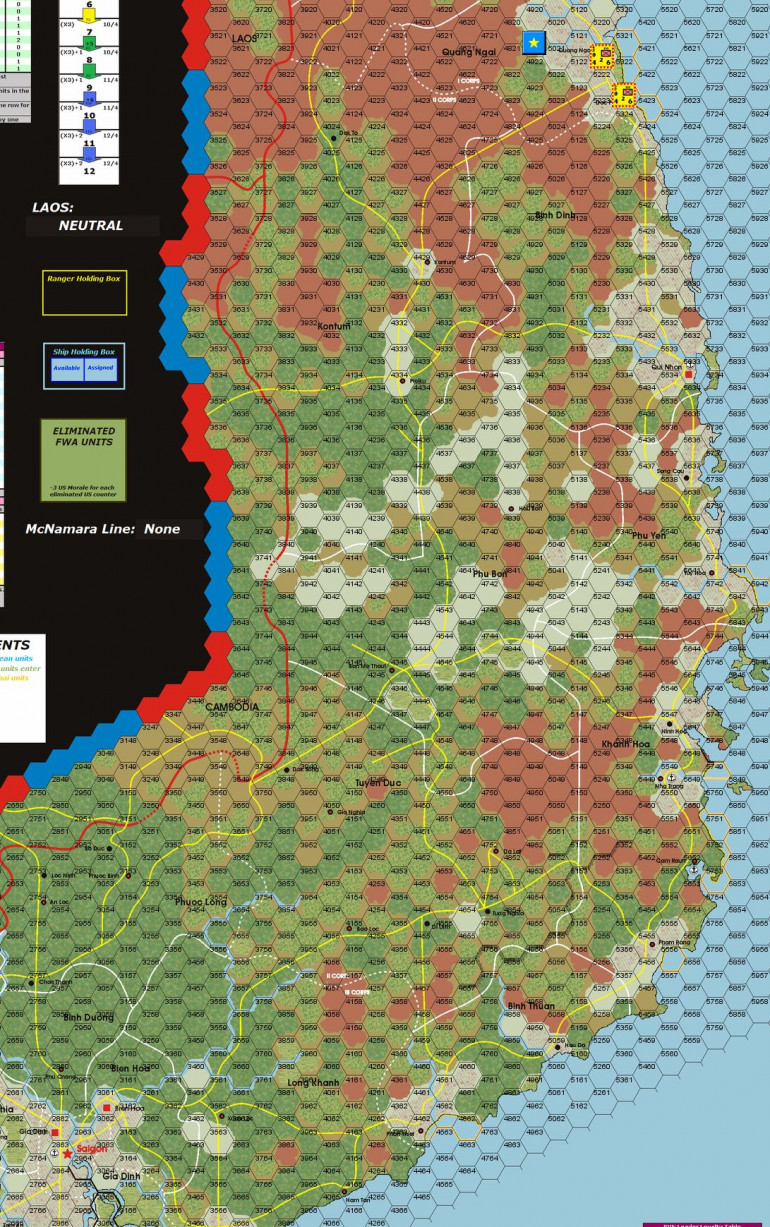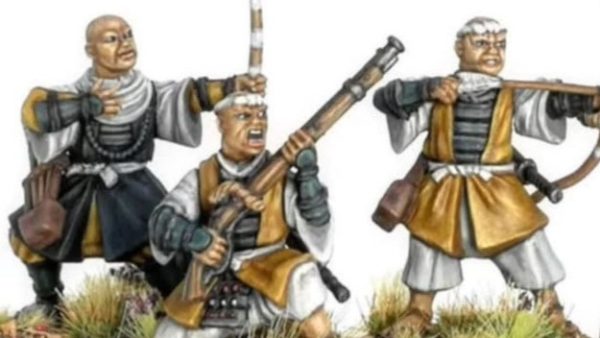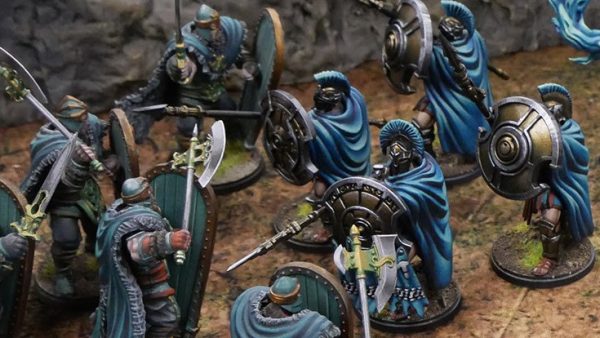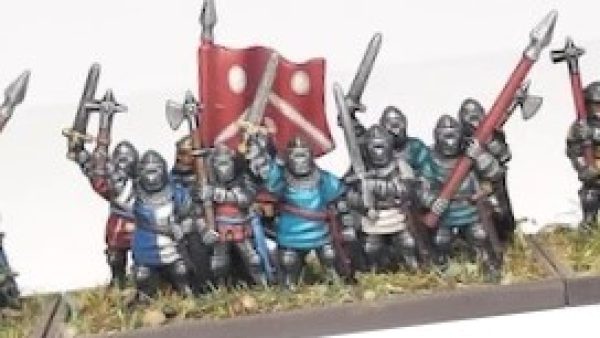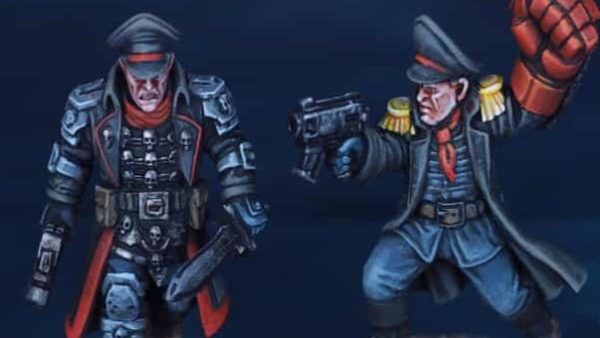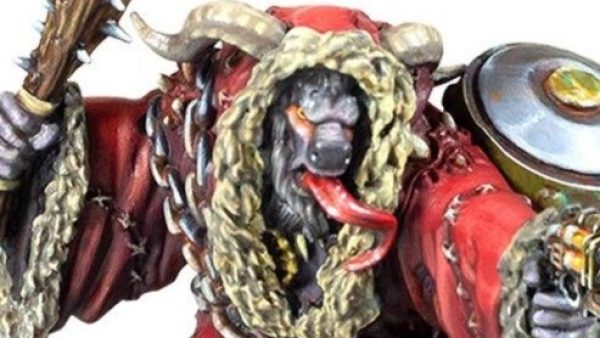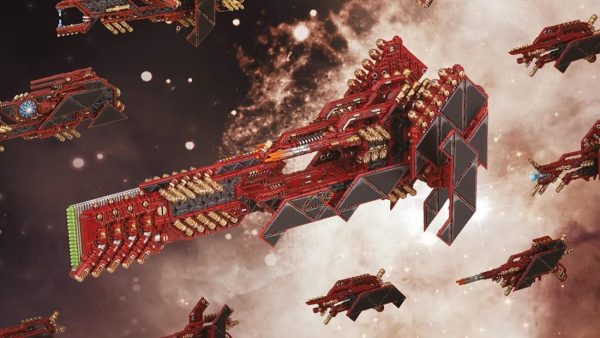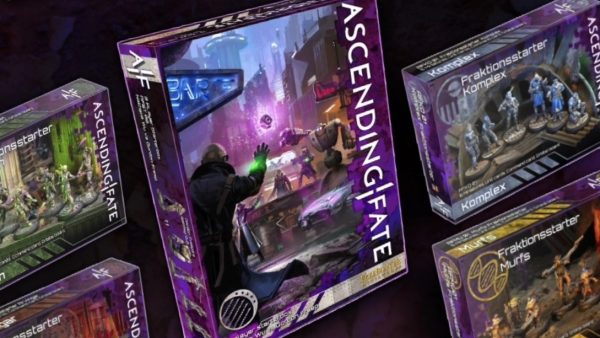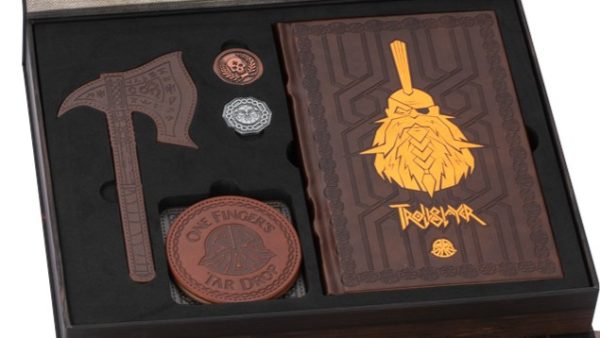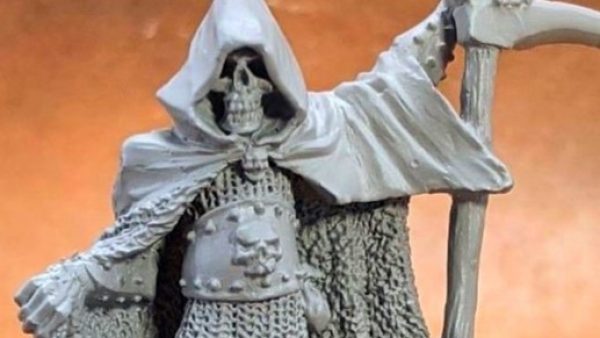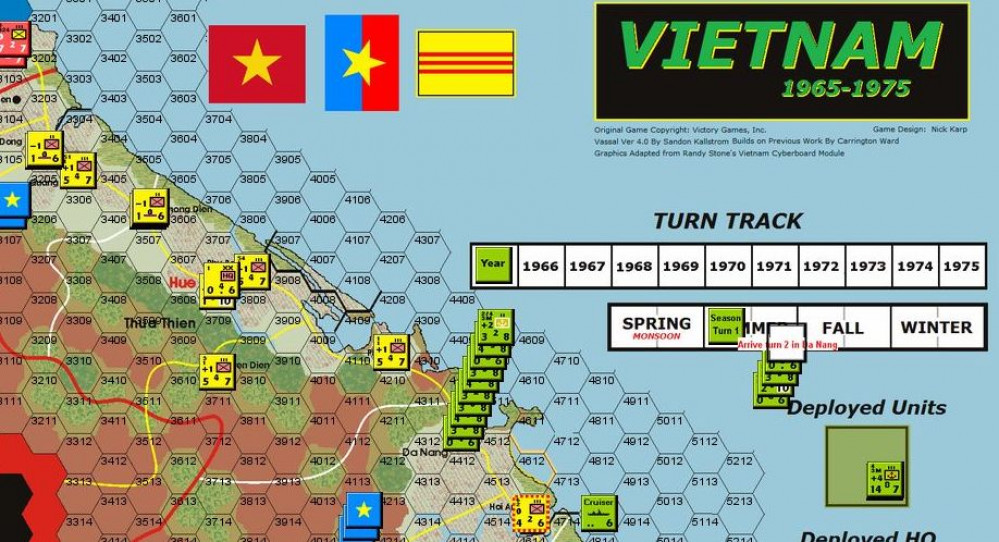
Vietnam 1965-75 Hex & Counter (Victory Games)
Recommendations: 16
About the Project
Oriskany's recent look at Vietnam, piqued my interest to re-visit an old hex-and-counter game I played (somewhat) as a teenager and rediscovered again in the last decade or so as a Vassal module. Victory Games' Vietnam 1965-75 is a battalion/regiment sized grand strategy game of the Vietnam War during the period of direct US involvement. This project hopes to introduce the game as seen in the Vassal module as well as include an example battle report from a scenario or two.
Related Company: Avalon Hill Games, Inc.
Related Genre: Historical
This Project is Completed
Game Introduction
The hard copy game is played on two 34×22″ sheets with a hex map of Vietnam and numerous charts and tables. Some scenarios allowed the use of one map overlapped on the other, but the larger scenarios and campaign game required both. The Vassal module combines this into a single screen that is a close approximation of the physical layout, with some tables and record counters added and rearranged.
The campaign game encompasses military and political aspects of the war playing either as US-controlled forces (USA, ARVN, Free World Allies) or as the National Liberation Front – NLF (North Vietnamese Army, Viet Cong). US morale is changed by game events, the ARVN army can be improved and provisioned, naval blockades limit the supplies getting to the NLF forces, Ho Chi Minh Trail effectiveness is abstracted to infiltrate forces deep along the Cambodia or Laos borders, strategic bombing of the North slows their build-up, South Vietnamese political and army leaders are modelled in different factions that can change over time and even initiate coups … the game was deep.
For the US player, the campaign is a balance between commitment (US resources in country, ARVN support) and morale back home. Morale is constantly decreasing and can drop quicker from heavy build-up of US forces, US losses, unrestrained bombing, or invasions of Laos or Cambodia. US commitment can never exceed morale. The US player is forced to act to maintain control of the population in each of the 35 regions on the map to ensure adequate supplies and manpower are available for the ARVN improvements, allowing them to replace US forces as morale drops. Control of towns, capitals and cultivated areas is key to ensure the population’s support.
The campaign game is won if the NLF player ever captures Saigon or controls a significant portion of South Vietnam population. The US player wins if they survive through spring 1975. Each year is split into 4 seasons and each season has 2 turns. A political phase occurs between seasons which modifies morale, commitment and population control.
The NLF player can build a strong and effective North Vietnamese army as well as the Viet Cong. VC can be deployed in areas of South Vietnam with friendly support from the population, can be formed in North Vietnam, or can infiltrate along the Ho Chi Minh Trail – an abstracted path that runs near the Cambodia/Laos border. Resources can be spent to improve it for movements and supplies, though the US player can devote resources to degrade and interdict the trail.
However the forces arrive on the map, the NLF player has some distinct advantages. They always choose who will take the next operation, to replicate the corruption of the civilian and military government as well as the aid of sympathizers. This allows them to focus on objectives, limiting the US player to defensive actions. If a battle turns in the US favour, though, by activating reserves and applying artillery or air support, they have inherent pursuit bonuses that can allow them to chase down and overrun retreating NLF forces.
The VC forces are also deployed face down, their type and strengths hidden from the US player until engaged in combat. The VC player also gets some dummy counters that can be used to mask where their real strength lies. A third tool is that if a stack containing VC counters is targeted by a US operation, the NLF player gets to make an alert roll that could allow them to disperse or move out of danger before the US forces ever reach them.
The NLF player can rarely take the fight directly to the US player, but are hard to track down and eliminate. This allows them to remain on board to control the SVN population in an effort to win.
The US player has a large array of ground forces to deploy, ranging from Marines, infantry, mechanized and airmobile troops. These can be used in 3 deployments:
Brigade level – entire formation as a single counter
Brigade HQ – 3 ground battalion counters with an additional HQ counter with artillery support
Alternate – 3 ground counters with brigade artillery split between them.
Each deployment has advantages depending on the role. The single counter is stronger when massed then when broken down, but it’s zone of control if limited to only the 6 surrounding hexes. Other deployments allow a spread of force that can slow the enemy’s movement through aggressive patrolling.
The US player has an array of independent artillery that can be brought onto the board, air points for tactical or strategic support, airmobile and riverine points to move troops quickly or enhance their pursuit through difficult terrain, and even a limited number of cruisers and a battleship that can provide bombardment support near the coast.
Gameplay
A unit counter can be assigned to an Operation once each turn (2 turns per season). A Search & Destroy operation is most common where your forces try to seek out and eliminate the enemy. The operating player designates acting forces and a target hex. They can then allocate support in the form of in-range artillery or air points. The operating player may impose offensive interdiction around the target hex to limit enemy movement. They make their movement, possibly incurring incidental attacks and, if they reach the target hex, combat ensues.
Total opposing strengths are tallied to determine the combat ratio, which modifies the roll of a single d6. Attacker and defender casualties are read off a corresponding table based on their unit strength plus the enemy’s artillery and air point total. Target forces have an opportunity to retreat, paying extra movement costs for terrain, leaving enemy hexes and zones of control and for interdiction placed. The combat result gives a Pursuit modifier which is added to a unit’s inherent bonus to see how far they can move in pursuit. Offensive and defensive reserves can be activated, potentially bringing new units into the fight or re-positioning them to cut off avenues of escape. If the attacker can reach the retreating unit’s hex, combat continues.
Casualties can be paid by removing units (costly, but sometimes the only option – greatest morale penalty if US counters removed). They may also be paid by replacement points, a resource generated for scenarios and in the campaign.
Other operations available to all include:
Hold – no zone of control, but increased strength and artillery values
Patrol – increased penalties to enemy units moving through zone of control
Bombardment – direct attack using only artillery or air points
The US player also has a few special operations available:
Clear & Secure – a search & destroy with reduced pursuit bonuses, any unit can switch to holding or patrol operations at the end of a combat round.
Security – allows a US stack to move entirely along a road, paying only movement costs to enter and leave enemy zones of control. May not move off-road, but engages in combat immediately if they encounter enemy unit on road with no Alert movement allowed.
When all units have acted or both players pass on conducting operations, the round ends and continues to the next. In a campaign game, a separate phase occurs between seasons called the seasonal interphase. This is where the effects of population pacification is determined, strategic bombing and blockades actions are issued, SVN politics are adjusted, new recruitment happens and new morale levels are set.
I’ve yet to finish a campaign, but each attempt brings new knowledge and a different experience that provides a glimpse into the myriad of factors that made this such a complicated struggle. The Vassal module is well supported with recent updates and a fairly active community reached from the Vassal site or even BGG. The rulebook is available with a little search-fu. If one is inclined to tinker with a full-blown strategic simulation of the Vietnam conflict, this is a great place to start.
I’m playing through one of the starting scenarios with a friend online and will try to post results. I’m the US player and he’s NLF, which means I dont get to see his VC units. He’ll have some screenshots for me after we finish, which I can compare to what I had during play.
Battle for I Corps - Turn 1
Posting up a battle report from a game played some time ago now, so my memory may be a little foggy on this one. This was played over the excellent Vassal module for this game and part of the delay was waiting on some image files from my opponent playing the NLF (VC/NVN) side. The VC counters display hidden for the US player as they only know where the VC have presence, but not necessarily the strengths until that unit acts.
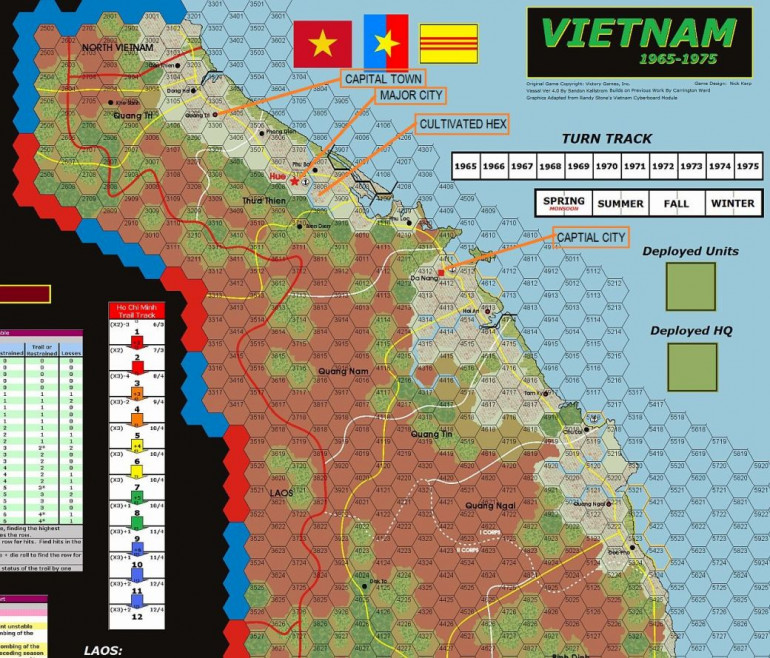 Quick note on scoring - typically, the NLF player receives victory points for each unit occupying city, capital and cultivated hexes at the end of a scenario. They also gain lots of points for entering a capital or major city during the scenario and eliminating US counters and a lesser amount of points for US Replacements expended to cover losses. The US player receives a smaller amount of points for VC units destroyed or dispersed or NVN counters destroyed or replacement points expended. The main focus for the US player in a scenario is not to lose control of the cities and population centers.
Quick note on scoring - typically, the NLF player receives victory points for each unit occupying city, capital and cultivated hexes at the end of a scenario. They also gain lots of points for entering a capital or major city during the scenario and eliminating US counters and a lesser amount of points for US Replacements expended to cover losses. The US player receives a smaller amount of points for VC units destroyed or dispersed or NVN counters destroyed or replacement points expended. The main focus for the US player in a scenario is not to lose control of the cities and population centers.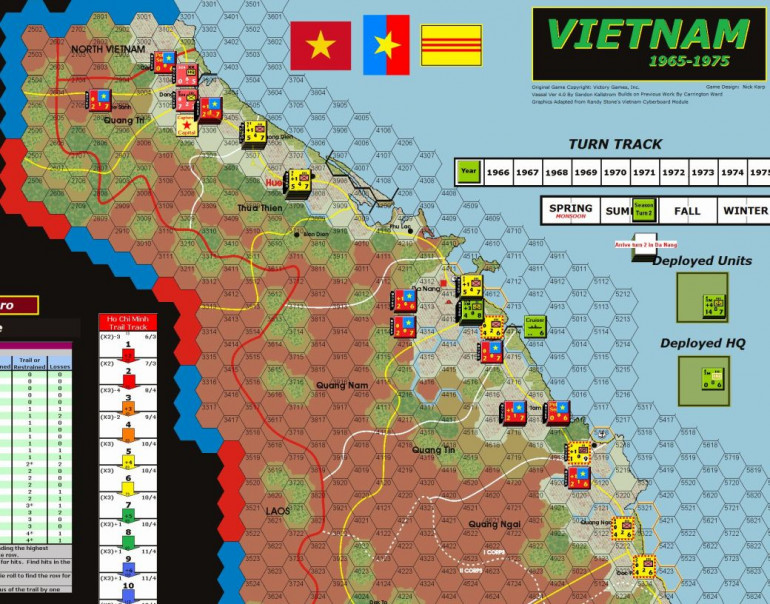 (NVN first actions shown) The Battle for I Corps scenario represents actions during the Tet offensive in the north of South Vietnam. 1st & 3rd Marine elements are present in dispersed deployments as is the 26th Marine in the consolidated deployment. Elements of the 101st, 23rd Division, 1st Cavalry and artillery support are also deployed. Battalion and regiments from the 1st and 2nd ARVN are available - the 2nd is 'ineffective' for the whole of the scenario (cannot conduct operations, essentially a garrison force). All US controlled forces start in pre-determined hexes. A Cruiser, respectable amount of Air Points and limited airmobile points are available to the US Player. The NVN player gets 2 VC regiments, 25 VC battalions and 6 Pol sections (dummy units) to deploy anywhere in the play area. The NVA 304th, 325th, & 320th divisions and some minor support can be deployed anywhere in NVN or Laos. The NLF player scores points for occupying even if expelled in this scenario, so it becomes a true rush for the population centers. Being an offensive (Tet), the NLF player scores a point for every attack made. Final scoring is (NLF score - US score). 65 or less is a US victory, 66-85 is a draw.
(NVN first actions shown) The Battle for I Corps scenario represents actions during the Tet offensive in the north of South Vietnam. 1st & 3rd Marine elements are present in dispersed deployments as is the 26th Marine in the consolidated deployment. Elements of the 101st, 23rd Division, 1st Cavalry and artillery support are also deployed. Battalion and regiments from the 1st and 2nd ARVN are available - the 2nd is 'ineffective' for the whole of the scenario (cannot conduct operations, essentially a garrison force). All US controlled forces start in pre-determined hexes. A Cruiser, respectable amount of Air Points and limited airmobile points are available to the US Player. The NVN player gets 2 VC regiments, 25 VC battalions and 6 Pol sections (dummy units) to deploy anywhere in the play area. The NVA 304th, 325th, & 320th divisions and some minor support can be deployed anywhere in NVN or Laos. The NLF player scores points for occupying even if expelled in this scenario, so it becomes a true rush for the population centers. Being an offensive (Tet), the NLF player scores a point for every attack made. Final scoring is (NLF score - US score). 65 or less is a US victory, 66-85 is a draw.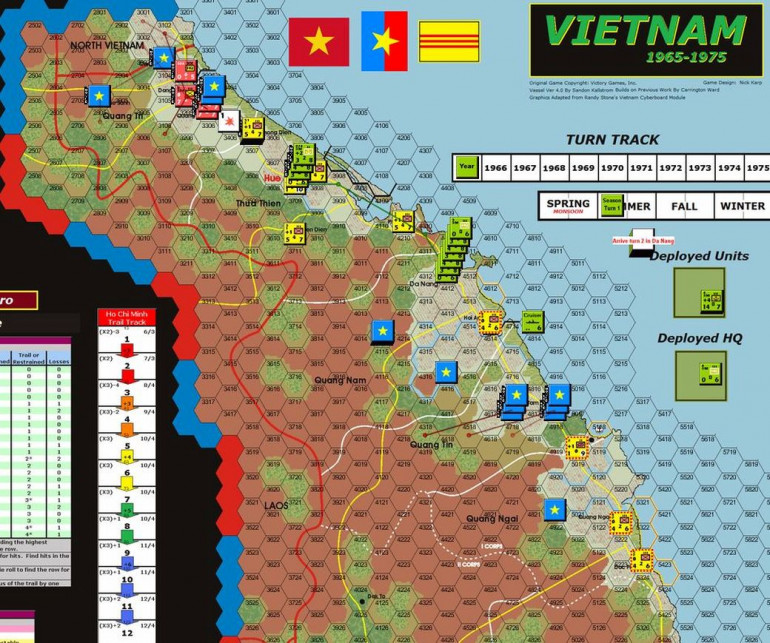 (US Player view) VC and NVN attacks in the north of the Corps pushed the ARVN forces out of Dong Ha and Quang Tri. 1st Marine elements moved from Da Nang to Hue. VC units in the south make some quick pushes in Quang Tri province to occupy towns and cultivated hexes. The NLF player controls the tempo of the game by usually having the option of deciding who gets to take the next action. In the campaign and other scenarios, they can benefit from being more passive and reacting to US movements. This scenario rewards attacks and quick gains and my opponent was being quite aggressive(!).
(US Player view) VC and NVN attacks in the north of the Corps pushed the ARVN forces out of Dong Ha and Quang Tri. 1st Marine elements moved from Da Nang to Hue. VC units in the south make some quick pushes in Quang Tri province to occupy towns and cultivated hexes. The NLF player controls the tempo of the game by usually having the option of deciding who gets to take the next action. In the campaign and other scenarios, they can benefit from being more passive and reacting to US movements. This scenario rewards attacks and quick gains and my opponent was being quite aggressive(!).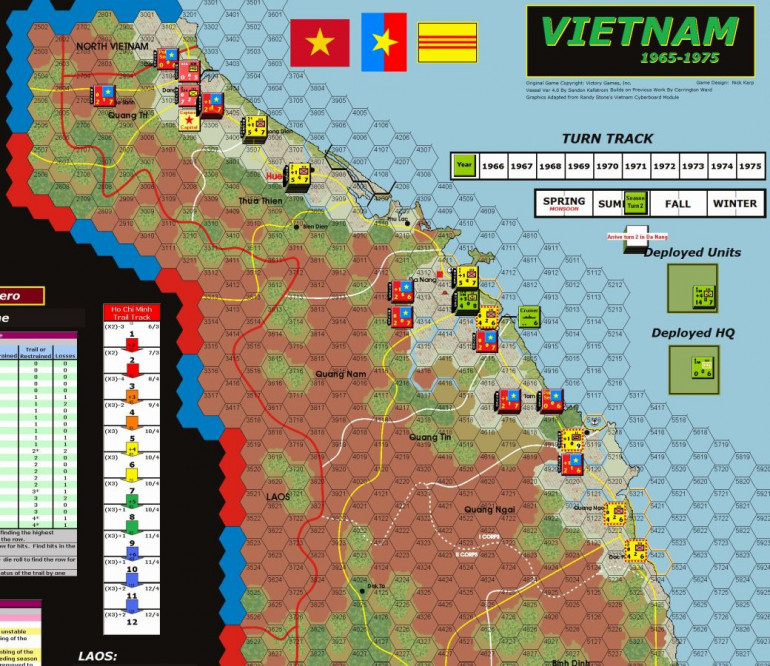 The first turn ended with some consolidating movements and preparation for operations in Turn 2. The US player receives reinforcements at the start of Turn 2 (3 1st Cav regiments and Div HQ). In hindsight, this is where I should have pushed more as the US Player. Worried about leaving critical hexes exposed, I fell into a reactive role and couldn't press to make gains.
The first turn ended with some consolidating movements and preparation for operations in Turn 2. The US player receives reinforcements at the start of Turn 2 (3 1st Cav regiments and Div HQ). In hindsight, this is where I should have pushed more as the US Player. Worried about leaving critical hexes exposed, I fell into a reactive role and couldn't press to make gains.Battle for I Corps - Turn 2
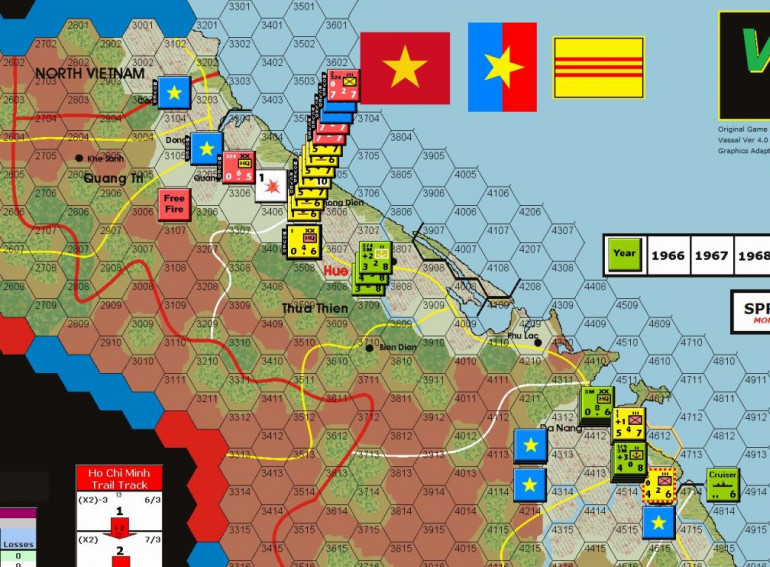 Turn 2 action started in the north with a VC/NVN thrust towards Hue. ARVN forces moved to reinforce, supported by US airpower. A Free Fire zone was declared by the US in this northern province to maximize their support at the expense of Victory points (arty and air points are halved in a non-free fire province, NVN gains 2 VP for each free fire zone). Interdiction was placed on the road to the north of the battle, but it was fruitless as the NLF forces overwhelmed the town of Phong Dien and pushed the ARVN troops back towards Hue.
Turn 2 action started in the north with a VC/NVN thrust towards Hue. ARVN forces moved to reinforce, supported by US airpower. A Free Fire zone was declared by the US in this northern province to maximize their support at the expense of Victory points (arty and air points are halved in a non-free fire province, NVN gains 2 VP for each free fire zone). Interdiction was placed on the road to the north of the battle, but it was fruitless as the NLF forces overwhelmed the town of Phong Dien and pushed the ARVN troops back towards Hue.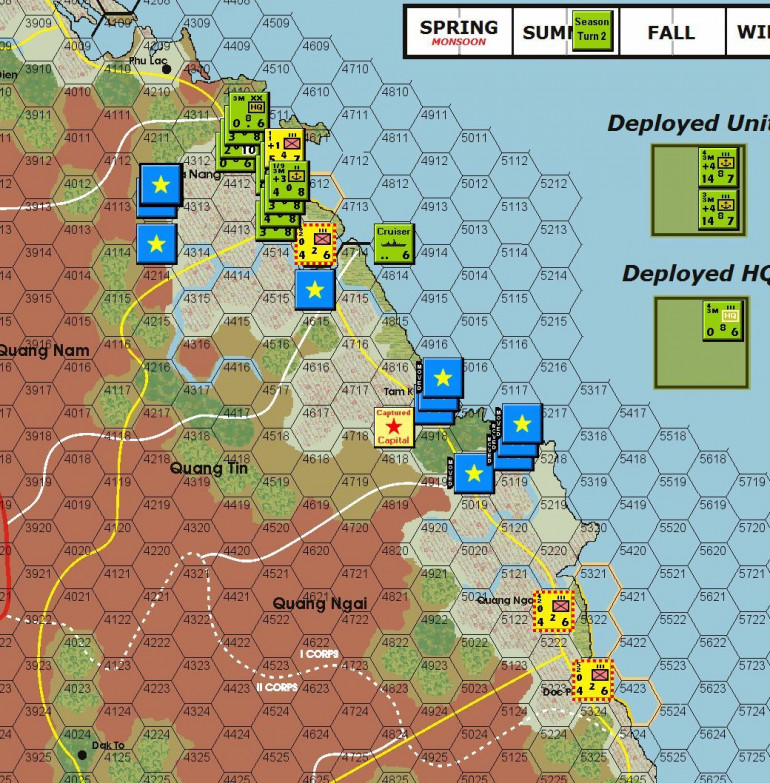 The NLF player continued the attacks in the south, focusing on the ineffective 2nd ARVN forces. These units were forced to retreat or disperse even with some limited US air power in support.
The NLF player continued the attacks in the south, focusing on the ineffective 2nd ARVN forces. These units were forced to retreat or disperse even with some limited US air power in support.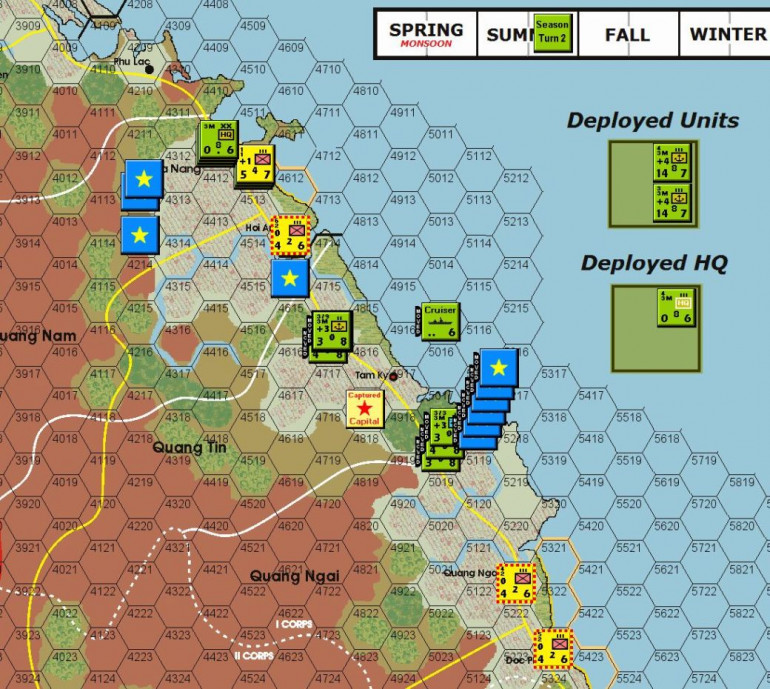 Elements of the 3rd Marines were activated as defensive reserves using airmobile points, and quickly got into contact with the attacking forces to start a push back. With a cruiser also moving to support, the US forces regained the lost towns, forcing the VC units into retreat. Follow-up attacks were poorly executed (dice rolls!!) and the VC forces could not be persuaded to leave the point-scoring cultivated hexes.
Elements of the 3rd Marines were activated as defensive reserves using airmobile points, and quickly got into contact with the attacking forces to start a push back. With a cruiser also moving to support, the US forces regained the lost towns, forcing the VC units into retreat. Follow-up attacks were poorly executed (dice rolls!!) and the VC forces could not be persuaded to leave the point-scoring cultivated hexes.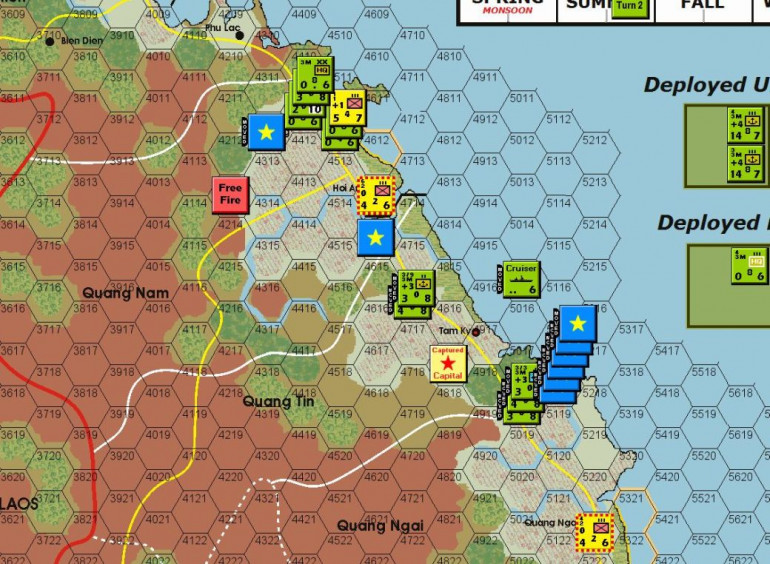 Final skirmishes in Quang Nam province were decisive for the US forces, but at the expense of heavy losses and use of support and reinforcements that still gained the NLF crucial victory points.
Final skirmishes in Quang Nam province were decisive for the US forces, but at the expense of heavy losses and use of support and reinforcements that still gained the NLF crucial victory points.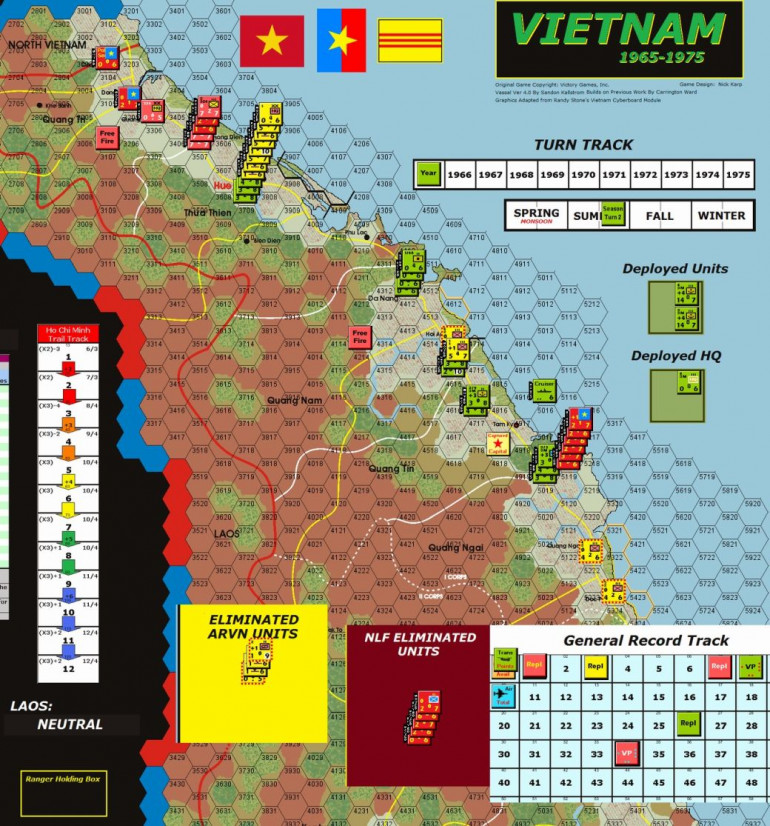 With the action over and the dust settled, the NLF player scored a narrow win with a final score of 87 (1 point past a draw!!). Early gains in the north could not be retaken by the US forces without putting critical towns at risk in the central area of the Corps. Limited US forces had to be everywhere in the face of dispersed NLF attacks with only tepid support from the ARVN forces.
With the action over and the dust settled, the NLF player scored a narrow win with a final score of 87 (1 point past a draw!!). Early gains in the north could not be retaken by the US forces without putting critical towns at risk in the central area of the Corps. Limited US forces had to be everywhere in the face of dispersed NLF attacks with only tepid support from the ARVN forces.This scenario captured the spirit of the Tet Offensive. Having not really been challenged in the population centres to this point, the US forces were caught flat-footed in the wake of numerous and widespread NLF attacks. On reflection, initial attacks may have been better made with the US troops instead of the ARVN forces for a better punch and a chance at regaining some territory. Played a little too passive and did not have the forces at hand to turn the tide once the NLF wave started to roll. The use of Free Fire zones and widespread support stemmed further advances, but gave away valuable Victory Points and handcuffed the US ability to act offensively.
The scenarios in Vietnam 1965-75 are meant to give a taste of different aspects of the game found in a full campaign. Aggression needs to be met with aggression during an offensive and the US player needs to take greater risks to keep momentum. In a campaign, an offensive has great impacts on US morale back home which curtails support available in subsequent turns. The NLF player may lose some battles, but this scenario shows how an offensive can go a long way towards winning a war.































